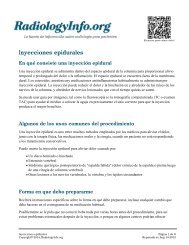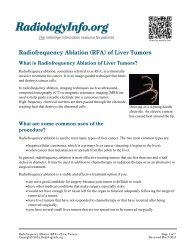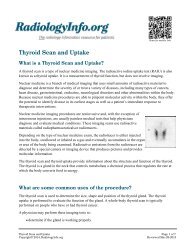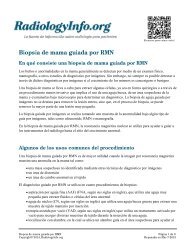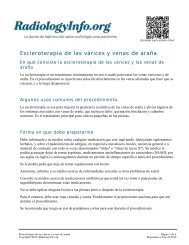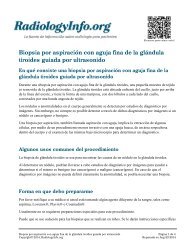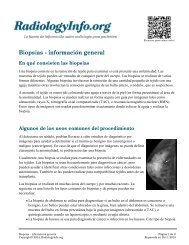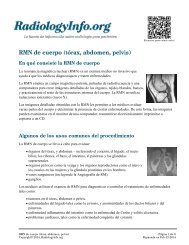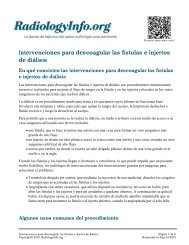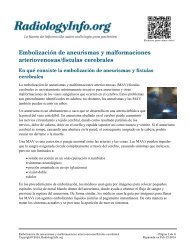Venography - RadiologyInfo
Venography - RadiologyInfo
Venography - RadiologyInfo
Create successful ePaper yourself
Turn your PDF publications into a flip-book with our unique Google optimized e-Paper software.
Scan for mobile link.<br />
<strong>Venography</strong><br />
What is a venogram?<br />
A venogram is an x-ray test that involves injecting x-ray contrast material (dye) into a vein to shows how<br />
blood flows through your veins. This allows a physician to determine the condition of your veins.<br />
An x-ray (radiograph) is a noninvasive medical test that helps physicians diagnose and treat medical<br />
conditions. Imaging with x-rays involves exposing a part of the body to a small dose of ionizing radiation<br />
to produce pictures of the inside of the body. X-rays are the oldest and most frequently used form of<br />
medical imaging.<br />
What are some common uses of the procedure?<br />
A venogram is commonly used to:<br />
assess the status of a vein or system of veins<br />
find blood clots within the veins<br />
assess varicose veins before surgery<br />
find a vein in good condition to use for a bypass procedure or dialysis access<br />
help a physician place an IV or a medical device, such as a stent, in a vein<br />
guide treatment of diseased veins.<br />
How should I prepare?<br />
Other than medications, you may be instructed to not eat or drink anything for several hours before your<br />
procedure.<br />
You may be allowed to drink clear liquids on the day of your procedure.<br />
You should inform your physician of any medications being taken and if there are any allergies,<br />
especially to iodinated contrast materials. Also inform your doctor about recent illnesses or other medical<br />
conditions.<br />
Women should always inform their physician and x-ray technologist if there is any possibility that they<br />
are pregnant. Many imaging tests are not performed during pregnancy so as not to expose the fetus to<br />
<strong>Venography</strong> Page 1 of 5<br />
Copyright© 2014, <strong>RadiologyInfo</strong>.org<br />
Reviewed Aug-5-2013
adiation. If an x-ray is necessary, precautions will be taken to minimize radiation exposure to the baby.<br />
See the Safety page (www.<strong>RadiologyInfo</strong>.org/en/safety/) for more information about pregnancy and<br />
x-rays.<br />
What does the equipment look like?<br />
The equipment typically used for this examination consists of a radiographic table, one or two x-ray tubes<br />
and a television-like monitor that is located in the examining room. Fluoroscopy, which converts x-rays<br />
into video images, is used to watch and guide progress of the procedure. The video is produced by the<br />
x-ray machine and a detector that is suspended over a table on which the patient lies.<br />
Other equipment that may be used during the procedure includes an intravenous line (IV), ultrasound<br />
machine and devices that monitor your heart beat and blood pressure.<br />
How does the procedure work?<br />
X-rays are a form of radiation like light or radio waves. X-rays pass through most objects, including the<br />
body. Once it is carefully aimed at the part of the body being examined, an x-ray machine produces a<br />
small burst of radiation that passes through the body, recording an image on photographic film or a<br />
special detector.<br />
Different parts of the body absorb the x-rays in varying degrees. Dense bone absorbs much of the<br />
radiation while soft tissue, such as muscle, fat and organs, allow more of the x-rays to pass through them.<br />
As a result, bones appear white on the x-ray, soft tissue shows up in shades of gray and air appears black.<br />
Veins cannot be seen on an x-ray; therefore, a special dye (called contrast material) is injected into veins<br />
to make them visible on the x-ray.<br />
How is the procedure performed?<br />
This examination is usually done on an outpatient basis.<br />
A venogram is done in a hospital x-ray department.<br />
A venogram is performed in the x-ray department or in an interventional radiology suite, sometimes<br />
called special procedures suite.<br />
You will lie on an x-ray table. Depending on the body part being examined (e.g., the legs), the table may<br />
be situated to a standing position. If the table is repositioned during the procedure, you will be secured<br />
with safety straps.<br />
The physician will insert a needle or catheter into a vein to inject the contrast agent. Where that needle is<br />
placed depends upon the area of your body where the veins are being evaluated. As the contrast material<br />
flows through the veins being examined, several x-rays are taken. You may be moved into different<br />
<strong>Venography</strong> Page 2 of 5<br />
Copyright© 2014, <strong>RadiologyInfo</strong>.org<br />
Reviewed Aug-5-2013
positions so that the x-rays can take pictures of your veins at different angles.<br />
What will I experience during and after the procedure?<br />
You may be asked to remove some or all of your clothes and to wear a gown during the exam. You may<br />
also be asked to remove jewelry, removable dental appliances, eye glasses and any metal objects or<br />
clothing that might interfere with the x-ray images.<br />
You will feel a slight pin prick when the needle is inserted into your vein for the intravenous line (IV)<br />
and when the local anesthetic is injected. The arteries have no sensation. Most of the sensation is at the<br />
skin incision site which is numbed using local anesthetic.<br />
As the contrast material passes through your body, you may get a warm feeling.<br />
You may have a metallic taste in your mouth. Your arm or leg may feel like it is getting numb or "falling<br />
asleep." After the test is complete, this feeling will go away.<br />
You must hold very still and may be asked to keep from breathing for a few seconds while the x-ray<br />
picture is taken to reduce the possibility of a blurred image. The technologist will walk behind a wall or<br />
into the next room to activate the x-ray machine.<br />
When the examination is complete, you will be asked to wait until the radiologist determines that all the<br />
necessary images have been obtained.<br />
A venogram takes between 30 and 90 minutes to perform. Fluids will be run through your IV to remove<br />
the contrast material from your veins. You will also be instructed to drink a lot of fluids for the next day.<br />
After the catheter is removed, a bandage will be placed on the IV site. Then you will be observed for any<br />
signs of complications, such as bleeding from the injection site, infection or an allergic reaction.<br />
Who interprets the results and how do I get them?<br />
A radiologist, a physician specifically trained to supervise and interpret radiology examinations, will<br />
analyze the images and send a signed report to your primary care or referring physician, who will discuss<br />
the results with you.<br />
Follow-up examinations may be necessary, and your doctor will explain the exact reason why another<br />
exam is requested. Sometimes a follow-up exam is done because a suspicious or questionable finding<br />
needs clarification with additional views or a special imaging technique. A follow-up examination may<br />
also be necessary so that any change in a known abnormality can be monitored over time. Follow-up<br />
examinations are sometimes the best way to see if treatment is working or if an abnormality is stable over<br />
time.<br />
What are some of the possible risks?<br />
<strong>Venography</strong> Page 3 of 5<br />
Copyright© 2014, <strong>RadiologyInfo</strong>.org<br />
Reviewed Aug-5-2013
There is a very slight risk of an allergic reaction if contrast material is injected.<br />
In rare cases, a venogram can cause a deep vein thrombosis.<br />
There is a risk of injury to the kidneys with contrast injection. Patients with impaired kidney (renal)<br />
function should be given special consideration before receiving iodine-based contrast materials by<br />
vein or artery. Such patients are at risk for developing contrast-induced nephropathy, in which the<br />
pre-existing kidney damage is worsened. See the Safety page<br />
(www.radiologyinfo.org/en/safety/index.cfm?pg=sfty_contrast) for more information about<br />
contrast materials.<br />
Any procedure that involves placement of a catheter inside a blood vessel carries certain risks.<br />
These risks include damage to the blood vessel, bruising or bleeding at the puncture site, and<br />
infection.<br />
There is always a slight chance of cancer from excessive exposure to radiation. However, the<br />
benefit of an accurate diagnosis far outweighs the risk.<br />
The effective radiation dose for this procedure varies. See the Safety page<br />
(www.<strong>RadiologyInfo</strong>.org/en/safety/) for more information about radiation dose.<br />
Because children are more sensitive to radiation exposure than adults, equipment and procedures<br />
will be monitored in order to deliver the lowest possible dose to young patients.<br />
A Word About Minimizing Radiation Exposure<br />
Special care is taken during x-ray examinations to use the lowest radiation dose possible while producing<br />
the best images for evaluation. National and international radiology protection organizations continually<br />
review and update the technique standards used by radiology professionals.<br />
Modern x-ray systems have very controlled x-ray beams and dose control methods to minimize stray<br />
(scatter) radiation. This ensures that those parts of a patient's body not being imaged receive minimal<br />
radiation exposure.<br />
What are the limitations of venography?<br />
The results of a venogram can be altered or affected if you are unable to sit still during the procedure<br />
since that will affect how the contrast material moves through your veins. Further exams may also be<br />
required if the more central veins located in the pelvis, abdomen and chest are not fully evaluated with<br />
contrast injection via an IV placed in the extremity.<br />
In some cases, ultrasound is a preferred procedure because it has fewer risks and side effects.<br />
Disclaimer<br />
This information is copied from the <strong>RadiologyInfo</strong> Web site (http://www.radiologyinfo.org) which is dedicated to<br />
providing the highest quality information. To ensure that, each section is reviewed by a physician with expertise in<br />
the area presented. All information contained in the Web site is further reviewed by an ACR (American College of<br />
Radiology) - RSNA (Radiological Society of North America) committee, comprising physicians with expertise in<br />
<strong>Venography</strong> Page 4 of 5<br />
Copyright© 2014, <strong>RadiologyInfo</strong>.org<br />
Reviewed Aug-5-2013
several radiologic areas.<br />
However, it is not possible to assure that this Web site contains complete, up-to-date information on any particular<br />
subject. Therefore, ACR and RSNA make no representations or warranties about the suitability of this information<br />
for use for any particular purpose. All information is provided "as is" without express or implied warranty.<br />
Please visit the <strong>RadiologyInfo</strong> Web site at http://www.radiologyinfo.org to view or download the latest<br />
information.<br />
Note: Images may be shown for illustrative purposes. Do not attempt to draw conclusions or make diagnoses by<br />
comparing these images to other medical images, particularly your own. Only qualified physicians should interpret<br />
images; the radiologist is the physician expert trained in medical imaging.<br />
Copyright<br />
This material is copyrighted by either the Radiological Society of North America (RSNA), 820 Jorie Boulevard, Oak<br />
Brook, IL 60523-2251 or the American College of Radiology (ACR), 1891 Preston White Drive, Reston, VA<br />
20191-4397. Commercial reproduction or multiple distribution by any traditional or electronically based<br />
reproduction/publication method is prohibited.<br />
Copyright ® 2014 Radiological Society of North America, Inc.<br />
<strong>Venography</strong> Page 5 of 5<br />
Copyright© 2014, <strong>RadiologyInfo</strong>.org<br />
Reviewed Aug-5-2013





